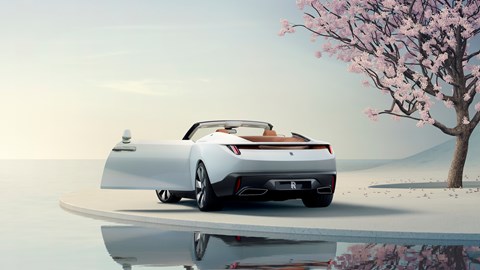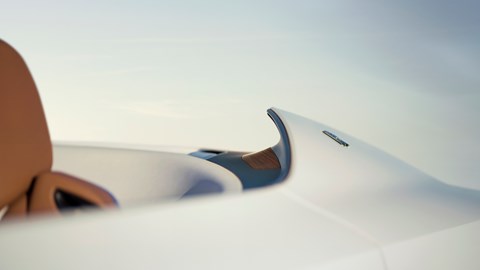► Latest one-off Rolls-Royce convertible
► Showcase for exquisite craftsmanship and bold design
► 593bhp from 6.75-litre V12 engine
If it seems odd to talk about a one-off multi-million-pound luxury car being simple, one glance at the pictures of the Rolls-Royce Arcadia should clarify matters.
This is the third of four versions of the Droptail being built by the Coachbuild department at Rolls-Royce’s Goodwood HQ. We’ve previously seen the red one (‘La Rose Noire’) and the blue one (‘Amethyst’), and now here is the white one (‘Arcadia’, alluding to a utopian pastoral vision, rather than a short-lived Duran Duran side project). The fourth Droptail won’t be made public, by the way; its owner prefers to keep it private.

Like the other Droptails, it’s a two-seat convertible built on a shortened aluminium, steel and carbonfibre chassis not shared with regular production Rolls-Royces. The 6.75-litre V12 engine is tuned to 593bhp and 620lb ft.
But the detachable carbonfibre roof is unique to this car, as are many of the details on the elegantly plain white exterior and the cossetting wood-and-leather interior.

We were among a select few who got up close to the hand-made one-off at Goodwood before it was shipped to its wealthy owner. That anonymous – and very fortunate – buyer was intimately involved with the creation of Arcadia over more than four years.
Our guide is Alex Innes, head of Coachbuild. He points out that a crucial difference to the other Droptails is that the carbonfibre sections at the bottom of Arcadia’s rear bodywork are painted, whereas they’re exposed on the others. This allows more use of that lucious paint: chiefly it’s solid white, infused with aluminium and glass particles, giving a shimmering effect and the illusion of great depth. It also emphasises the car’s low, muscular stance.

There are 233 pieces of wood used, 76 of them on the rear deck, and some of them bolstered by unseen carbonfibre. To preserve the wood, coatings used on superyachts were deemed inadequate, as they would need regular reapplication, and instead Rolls developed its own, which should last the lifetime of the car.
The wood on the deck is not just decorative. Says Innes: ‘Aerodynamicists will tell you not to have a droptail shape, but we’ve overcome the problems by ensuring the shape of the wood guides the air appropriately.’

He’s particularly proud of the shape of the roof. ‘It’s less casual than the roof on the other Droptails, and requires a couple of people and a few minutes – a conscious choice to take it off or put it on.’
And although it’s supremely simple at a glance, the dash includes the most complex clock face Rolls-Royce has ever been involved with – assembly took five months, notes Innes.
Coachbuild cars are made at Goodwood, but they don’t go down the same production line as Phantoms, Cullinans, Ghosts and Spectres.

‘We build Coachbuild cars like they build a yacht,’ says Innes; ‘the car stays in one place, we move to it.’
But for all its finery, Arcadia is a car designed to be used. Fully road legal and (virtually) crash-tested, it has pop-up crash-protection hoops behind the occupants’ heads, designed to burst through that exquistely crafted wood if the worst should happen.
Muses Innes: ‘All of this complexity and effort to achieve something that looks natural…’ But he’s hugely proud of the result of his team’s collaboration with the client, in creating something timelessly elegant: ‘You can imagine in 100 years this car not being recognised as being from the 2020s.’

What next for this brilliant design? In theory, nothing. Innes insists that the nature of Coachbuild means its clients get something truly unique – so this is not to be seen as a preview of future two-seat convertible Rolls-Royces. But that said, Rolls design chief Anders Warming is a frequent visitor to the Coachbuild studio, and can’t have failed to have been wowed by Arcadia. His tape measure will doubtless have confirmed that the Spectre’s electric underpinnings could be shoe-horned in.